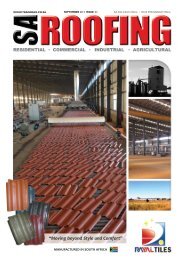October 2012 - Trademax Publications
October 2012 - Trademax Publications
October 2012 - Trademax Publications
Create successful ePaper yourself
Turn your PDF publications into a flip-book with our unique Google optimized e-Paper software.
CIFOR<br />
Jepara made its name as the go-to source for tropical<br />
hardwood furniture in the 19th century when a local<br />
noblewoman, Indonesian feminist icon, R.A. Kartini, sent<br />
Queen Wilhelmina of Holland hand carved furniture as a<br />
wedding gift.<br />
However, only after the 1998 Asian economic meltdown<br />
did Jepara take off as the international source for lowvalue<br />
mahogany and teak furniture. Yet, just as foreign<br />
markets allowed Jepara to soar above Indonesia’s<br />
economic depression in the late 1990s, so its exportdependency<br />
exposed it to the 2008 global downturn while<br />
the rest of the country remained relatively immune.<br />
CIFOR launched the Furniture Value Chain (FVC) project in<br />
Jepara in 2008. The purpose of the project was to help<br />
small producers acclimate to international markets that<br />
they had entered after the 1998 Asian financial crisis.<br />
Illegal logging and a weak rupiah in 1998 had created<br />
prime circumstances for an export furniture market,<br />
explained Purnomo. Although, in the early 2000s,<br />
Indonesia’s economy stabilised and logging became more<br />
controlled, many Jepara carvers had a hard time adjusting.<br />
Competition in price from China, and competition in<br />
quality from furniture manufacturers elsewhere in Java<br />
created further hardships. But no sooner had the FVC<br />
project started, than the global context changed. The<br />
international market for Jepara carvings slowed as<br />
consumers abroad cut back on spending. The incentive to<br />
reforest decreased due to the decreased demand for wood<br />
from the furniture industry. Yet, CIFOR research continued<br />
to work with small-scale producers.<br />
Now, in their latest paper, Purnomo and Fauzen profile<br />
large, medium and small furniture producers in the wake<br />
of the 2008 crisis. Interviewees ranged from a homebased<br />
family of carpenters all the way up to a mechanised<br />
factory with a payroll of 150 workers. The family business<br />
hand-carved chairs for the domestic market, while the<br />
mechanised plant produced “green furniture” for Western<br />
markets, as certified by the Forest Stewardship Council<br />
(FSC) or the Verified Legal Origin (VLO).<br />
When orders dried up in the economic downturn, Purnomo<br />
and Fauzen found that women were the first to be booted<br />
off the payroll. At every level of industry, businesses were<br />
shifting to a domestic market or adjusting to slower and<br />
fewer payments from foreign buyers. So producers cut<br />
corners, eliminating “value-added” stages, starting with<br />
the least skilled and lowest paid, such as sanding –<br />
traditionally women’s work. Hardest hit by the crisis,<br />
according to Purnomo, were the largest operations,<br />
including those who had “gone green.” Their businesses<br />
hinged on just a few big international wholesalers or<br />
retailers, he explains, and “in that kind of hierarchical<br />
value chain, there is no competition between buyers. They<br />
set the price and suppliers just have to take it.”<br />
“The only solution,” Purnomo says, “is for suppliers to<br />
diversify their markets.” The domestic market could offer<br />
a way out, judging from surveys that Purnomo has led,<br />
which showed a sizeable proportion of Indonesian<br />
consumers (16% of 408 people interviewed) would be<br />
willing to pay nearly 20% higher for green certified<br />
furniture – a “green” premium about on a par with English<br />
consumers and twice as high as Norway’s, according to<br />
recent research.<br />
The problem, though, is that Indonesia lacks a domestic<br />
certification mechanism comparable to the USA’s Lacey<br />
Act or Europe’s Volunteer Partnership Agreement that<br />
have made similar sustainability demands there law.<br />
“Willingness to pay must come with law enforcement,”<br />
says Purnomo. “For the domestic market, there is a<br />
willingness to pay but there is no rule or law.” He<br />
recognises that the case presents a catch-22 dilemma,<br />
though: consumers won’t buy “green furniture” unless it’s<br />
certified, but the government won’t set up a certifying<br />
agency until there’s demonstrated consumer demand.<br />
He expects that the dilemma will resolve itself as Jepara’s<br />
furniture bounces back – wiser this time, he hopes, after<br />
its post-2008 near-death experience.<br />
Read more:<br />
• Uncovering the complexity: An essay on the<br />
benefits of the value chain approach to global<br />
crisis studies-a case study from Jepara, Indonesia<br />
by Fauzan A.U.; Purnomo, H.<br />
• Women championing the preservation of an<br />
invaluable cultural heritage by Nita Murjani<br />
• New timber regulation to force companies away<br />
from business-as-usual practices by Leoni Aurora<br />
Published with permission from CIFOR.<br />
For more information visit www.cifor.org.<br />
// OCTOBER <strong>2012</strong> 55















